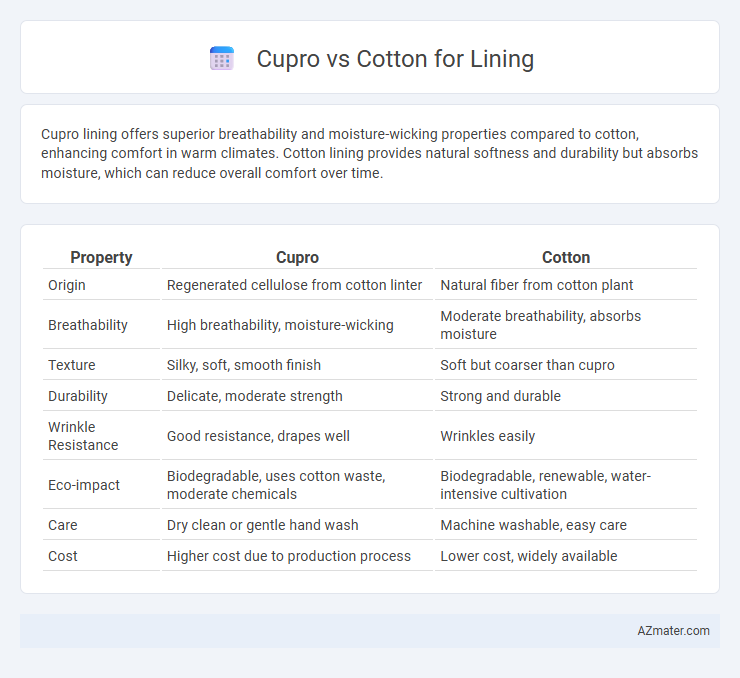Cupro lining offers superior breathability and moisture-wicking properties compared to cotton, enhancing comfort in warm climates. Cotton lining provides natural softness and durability but absorbs moisture, which can reduce overall comfort over time.
Table of Comparison
| Property | Cupro | Cotton |
|---|---|---|
| Origin | Regenerated cellulose from cotton linter | Natural fiber from cotton plant |
| Breathability | High breathability, moisture-wicking | Moderate breathability, absorbs moisture |
| Texture | Silky, soft, smooth finish | Soft but coarser than cupro |
| Durability | Delicate, moderate strength | Strong and durable |
| Wrinkle Resistance | Good resistance, drapes well | Wrinkles easily |
| Eco-impact | Biodegradable, uses cotton waste, moderate chemicals | Biodegradable, renewable, water-intensive cultivation |
| Care | Dry clean or gentle hand wash | Machine washable, easy care |
| Cost | Higher cost due to production process | Lower cost, widely available |
Introduction to Cupro and Cotton Linings
Cupro linings consist of regenerated cellulose fibers derived from cotton linter, offering a smooth, breathable, and moisture-wicking fabric ideal for high-end garments. Cotton linings, made from natural cotton fibers, provide softness, durability, and excellent breathability, making them a popular choice for comfort-focused apparel. Both materials excel in breathability and comfort, but cupro is often favored for its silky texture and luxurious feel in suit linings and delicate garments.
What is Cupro Fabric?
Cupro fabric is a regenerated cellulose fiber derived from cotton linter, offering a silky texture and excellent breathability ideal for lining garments. It absorbs moisture effectively while remaining lightweight and smooth against the skin, outperforming traditional cotton liners in comfort and drape. Cupro's biodegradable nature and resistance to static and wrinkles make it a sustainable and practical alternative for luxury clothing linings.
Understanding Cotton as a Lining Material
Cotton as a lining material offers natural breathability and softness, making it ideal for comfort in garments and accessories. Its moisture-absorbing properties help regulate temperature and reduce sweat buildup, enhancing wearability during prolonged use. Compared to synthetic options, cotton linings provide hypoallergenic benefits and are easier to care for, maintaining durability through multiple washes.
Environmental Impact: Cupro vs Cotton
Cupro, made from regenerated cellulose fibers derived from cotton linter, offers a sustainable alternative by utilizing cotton industry waste, reducing landfill contributions and chemical pollution compared to conventional cotton farming. Cotton cultivation demands significant water resources, pesticides, and fertilizers, leading to soil depletion and environmental strain, whereas Cupro's closed-loop production minimizes chemical discharge and water usage. Although both fabrics have environmental footprints, Cupro's manufacturing process presents a more eco-friendly option by repurposing by-products and promoting circular textile production.
Breathability and Comfort Comparison
Cupro offers superior breathability compared to cotton due to its natural moisture-wicking properties, allowing air to flow freely and keeping the skin dry and cool. Cotton provides comfort with its softness and hypoallergenic nature but tends to retain moisture, which can reduce overall breathability. For linings, cupro is often preferred in high-end garments for enhanced comfort and temperature regulation, while cotton remains a popular choice for its natural feel and durability.
Durability and Longevity
Cupro lining offers superior durability compared to cotton due to its strong, regenerated cellulose fibers that resist wear and maintain structure over time. Cotton, while breathable and soft, tends to degrade faster with repeated laundering and friction, which can reduce the longevity of the lining. Cupro's resistance to pilling and its smooth texture ensure a longer-lasting, high-quality finish ideal for frequent use in garments.
Cost Differences Between Cupro and Cotton Linings
Cupro linings typically cost more than cotton due to their complex production process involving regenerated cellulose fibers derived from cotton linter. The price difference reflects Cupro's smooth, silk-like texture and superior breathability, which justify higher retail values compared to the more affordable, widely available cotton. Cotton remains a budget-friendly option favored for its natural fiber qualities and ease of maintenance, making it popular in cost-sensitive garment linings.
Sustainability and Ethical Considerations
Cupro lining, derived from recycled cotton waste through a closed-loop production process, offers a highly sustainable and eco-friendly alternative to conventional cotton, which requires intensive water and pesticide use. Cotton cultivation is resource-intensive and often associated with ethical concerns such as labor exploitation, whereas Cupro's manufacturing reduces water consumption and promotes waste valorization, aligning with circular economy principles. Brands prioritizing sustainability increasingly favor Cupro for its biodegradable qualities and lower environmental footprint, enhancing ethical fashion standards.
Care and Maintenance Tips
Cupro linings require gentle care, preferably dry cleaning, as they are delicate and prone to shrinkage or distortion if washed improperly. Cotton linings are more durable and machine washable, making them easier to maintain, but they may wrinkle or shrink without careful laundering. To extend the longevity of both fabrics, store garments in cool, dry places and avoid excessive exposure to direct sunlight.
Which Lining Should You Choose: Cupro or Cotton?
Cupro lining offers a luxurious, silky feel with excellent breathability and moisture-wicking properties, making it ideal for high-end garments requiring smooth texture and comfort. Cotton lining provides durability, natural fiber benefits, and better temperature regulation, suitable for casual wear and eco-conscious choices. Choosing between cupro and cotton lining depends on the desired balance of softness, durability, and breathability specific to the garment's purpose.

Infographic: Cupro vs Cotton for Lining
 azmater.com
azmater.com